1. PROBLEM
As mentioned in the description section, earthquakes are noted as the second most common natural disasters throughout the world.
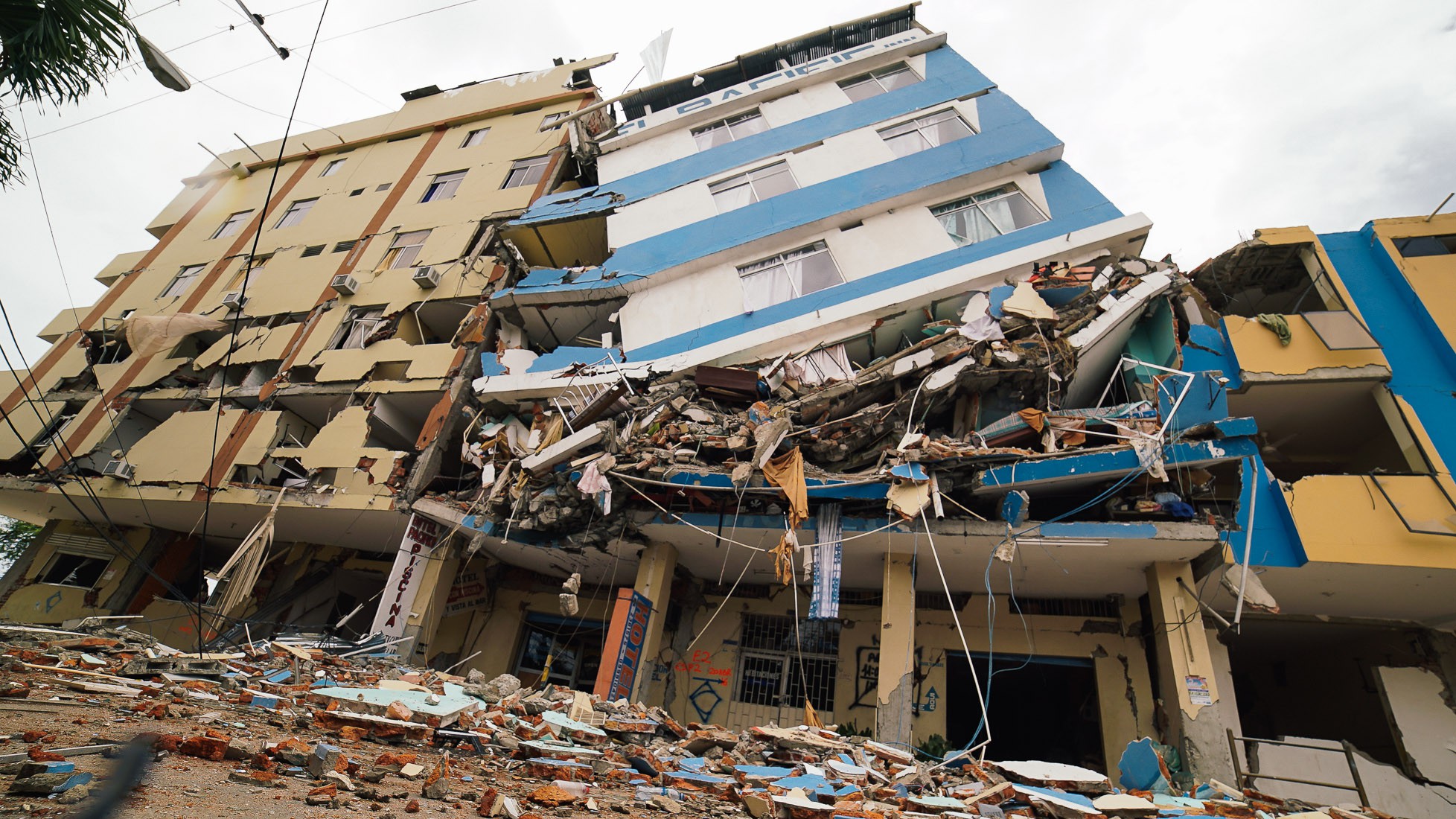
In 2015, earthquakes exceeding a magnitude of 5.5 in developed
countries resulted with direct and indirect economic damages fluctuation
between $2 million to $232 billion; for some countries, such as Japan, a decade
of events have resulted in losses in the trillions. Residential damage only results in a quarter
of the losses, with the remaining impact falling upon the realm of secondary
effects; these degradations include tsunamis, landslides, shaking, liquefaction
and fire. GDP, Socioeconomic and public
health impacts are directly affiliated with the aftermath of earthquakes;
however, thirty percent of all direct losses incurred are damages to
infrastructure. Additionally, 2010 earthquake statistics reflect a
worldwide causality total of 320,120 people. Proportional collapses do depend on the
characteristics of ground motion, with a majority of fatalities occurring in
direct correlation with structural compromise.
A revolutionary new technology may be able to mitigate the economic and humanitarian costs associated with the earthquakes.
2. OUR SOLUTION
2.1 Background
Metamaterials are a novel technology that functions by redirecting waveforms around their surface, acting somewhat as a 2D waveguide. Metamaterials were initially speculated for futuristic applications, such as providing optical invisibility or cloaking.
In addition to optical metamaterials, researchers have created seismic metamaterials.
Seismic metamaterials essentially shorten incoming seismic waves and direct them around their structure. In this manner, the building in the center of the metamaterial matrix is “invisible” to seismic waves. This is a process known as “acoustic cloaking,” where the sound waves bend around an object rather than reflecting from its acoustic surface. This technology has the added benefit of “lack of scattering” forward or behind the seismic metamaterial structure, thus omitting dangerous compromise to any nearby structures.
The specific subset of seismic metamaterials pursued here are a mass-in-mass system that redirects and filters the more destructive S-waves around shielded structures. The novelty of our idea comes from that it can be tuned to various quake frequencies.
2.2 The Hardware
The system, deemed The Optimized Seismic Concentric Interference Longitudinal Lattice Apparatus (OSCILLA), is a low-cost seismic metamaterial system which can be deployed rapidly with minimal infrastructure. The OSCILLA system itself is composed of many subunits (also referred to as “unit cells” in metamaterial parlance) which collectively interact with the incident seismic wave. This array of smaller units also has the added benefit of simplifying the installation process, allowing the subunits to be placed underground using minimal equipment.
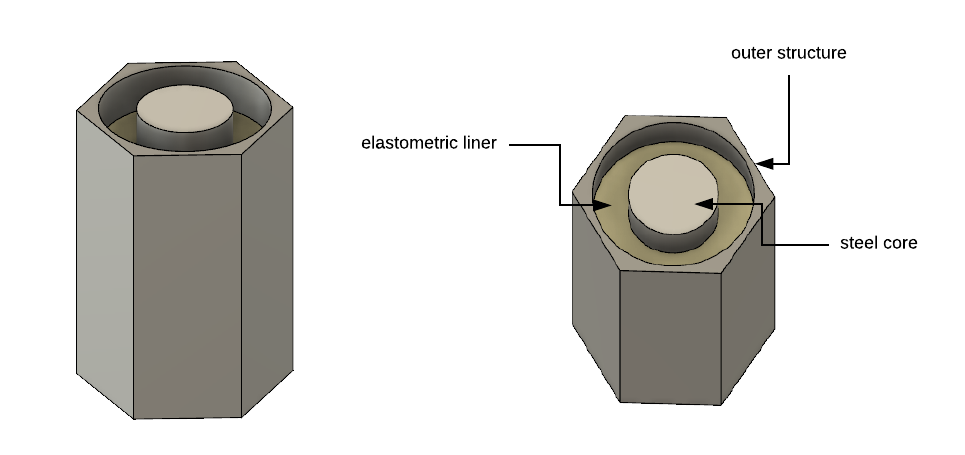
Figure 1: a. Overall design of the OSCILLA unit cell (left) and primarily components of an OSCILLA unit cell (right).
The placing of the unit cells

Figure 2: Configuration of the OSCILLA unit cells. a. The unit cells are in a contact configuration, whereas in b. the cells are in a spaced configuration. The unit cells can even be arranged in a hybrid configuration as seen in c., depending upon the local topography.
The OSCILLA subunits collectively act as a resonator, oscillating at the frequency of the incident surface waves. Each subunit can thus be more accurately referred to as a periodic unit cell, since they are individual resonators that match the frequency and period of the quake’s oscillations. In doing so, the seismic wave itself bends around the central structure. A metamaterial by definition must contain periodic unit cells, which collectively compose the surface of the metamaterial itself. These unit cells are smaller than the incident wavelength. The periodicity of these units can be seen as analogous to the periodicity of the units in a crystalline lattice. In this same manner, a metamaterials structure redirects the incidence waves, whether there are electromagnetic, mechanical, or acoustic. The structure of the periodic unit cells in OSCILLA can be classified as local resonance inclusions, with a central core that oscillates in accordance with frequency of the quake.
Here is a proof-of-concept arrangement of the OSCILLA unit cells around a building to be protected against an earthquake:
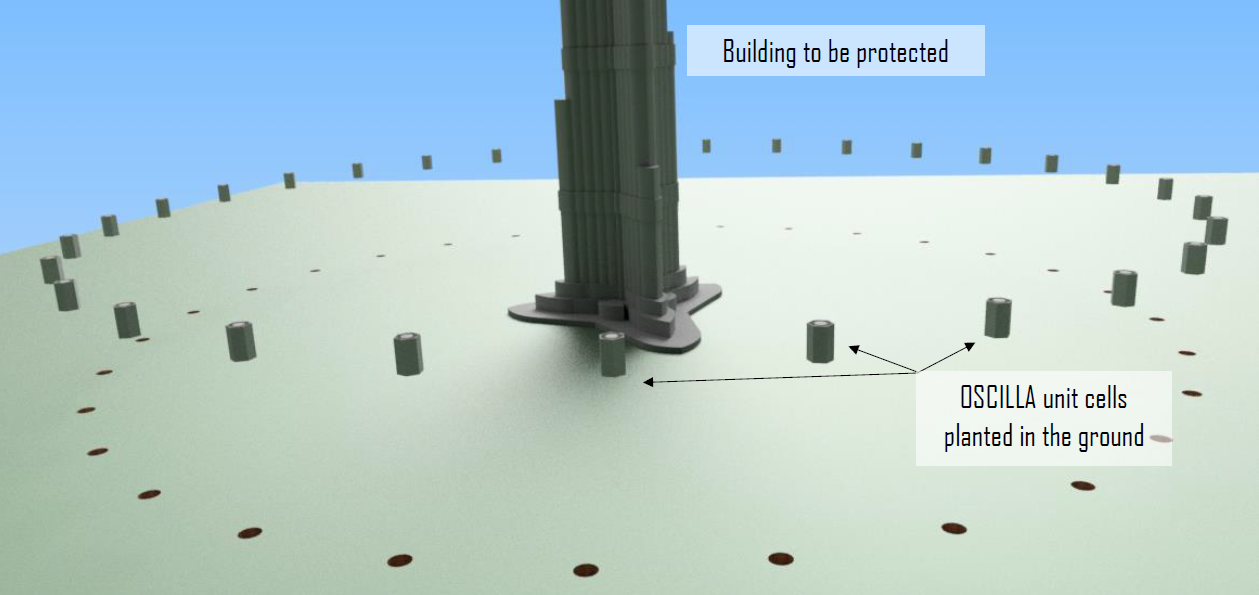
The medium inside of one unit cell
As for the medium inside the OSCILLA subunits, it must be elastic to effectively transform the shock of the earthquake from the soil outside the surface of the subunit to the mass in the center of the subunit. In principal, this material must have the properties of an elastomer, with a relatively high elasticity and viscosity, in addition to high failure strain and a low Young’s modulus.
In the proposed unit’s design, as well as the subsequent simulations performed, conventional rubber was simply used and provided satisfactory results.
Running a simulation
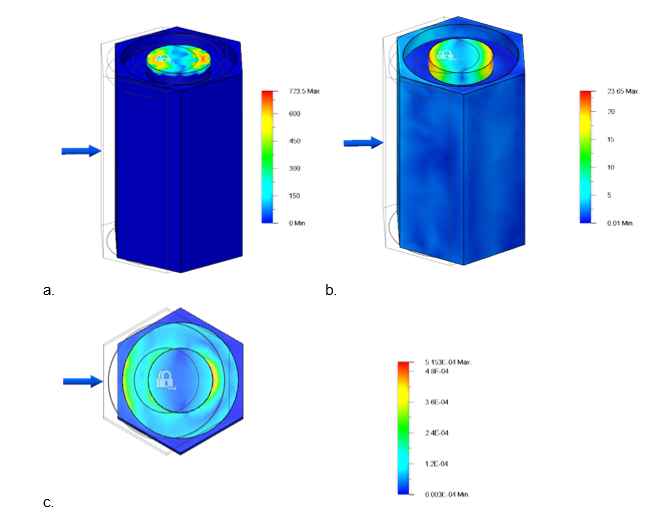
Figure 3:
Simulated earthquake-like forces on OSCILLA unit cells.
a. The reaction force of the unit cell can be seen largely in the central steel core, as characteristic of mass-in-mass resonators.
b. The mechanical stress on the OSCILLA unit cell, as modeled using the von Mises yield criterion.
c. The strain on the unit cell can be seen here as transferred to the elastomeric medium (in this case, a conventional rubber) as designed.
As a proof-of-concept, the OSCILLA unit cells were exposed to earthquake-like forces in a computation simulation. The simulation displayed that the unit cells functioned as planned with the oscillatory force of the quake being transferred to the central mass inside the encapsulation, with the elastomeric liner acting as a conduit of sorts. As stated before, the simulation simply used a common rubber compound to stand in for the elastomeric liner.
Compensating differences in earthquake frequencies
Seismic metamaterials can only redirect quake in a narrow frequency interval.
To compensate for differences in earthquake frequencies, each final OSCILLA unit cell has a triaxial inertial motion sensor unit to detect the precise frequency of the earthquake’s S-waves. This allows each OSCILLA unit to adaptively adjust the movement of the core using actuators positioned around its structure. These actuators allow the OSCILLA unit cell can exactly match the frequency of the earthquake to redirect the waves around the central structure that the units are placed around. The actuators create a tunable metamaterial that can finely adjust the resonance of each OSCILLA unit.
By the addition of active devices such as actuators, OSCILLA can be utilized for a wide range of earthquake frequencies.
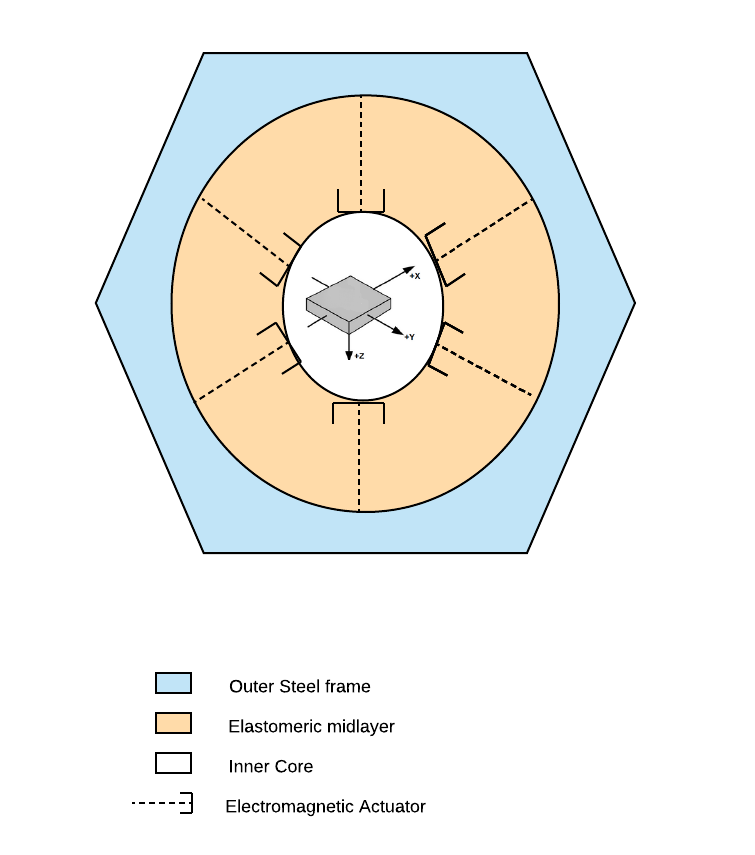
Figure 4: A labeled cross-section of the OSCILLA unit cell. The radially arranged actuators receive input during an earthquake from the accelerometer (center).
The use of a sensitive accelerometer as an active feedback system dramatically increases the performance of each OSCILLA unit and of the OSCILLA array. In addition, this active system allows for increases dampening as compared to a purely passive unit cell structure.
The highly precise accelerometer used in the OSCILLA units
We are going to use a highly precise accelerometer, also designed by us to perform the accuracy that needed. A 'photo-microphone' is going to be used to sense the frequency of earhquakes.
A photo-microphone consists of a membrane, a laser beam source, a photo sensor, and a relfecting surface placed at the membrane. The laser beam reflects from the highly sensitive membrane, thus allowing us to measure the frequency of quakes.
The idea of using this apparatus came from Léon Theremin's spy mechanism: he used a low-energy infra laser-beam aimed to a room's window to listen to the conversation in the room.
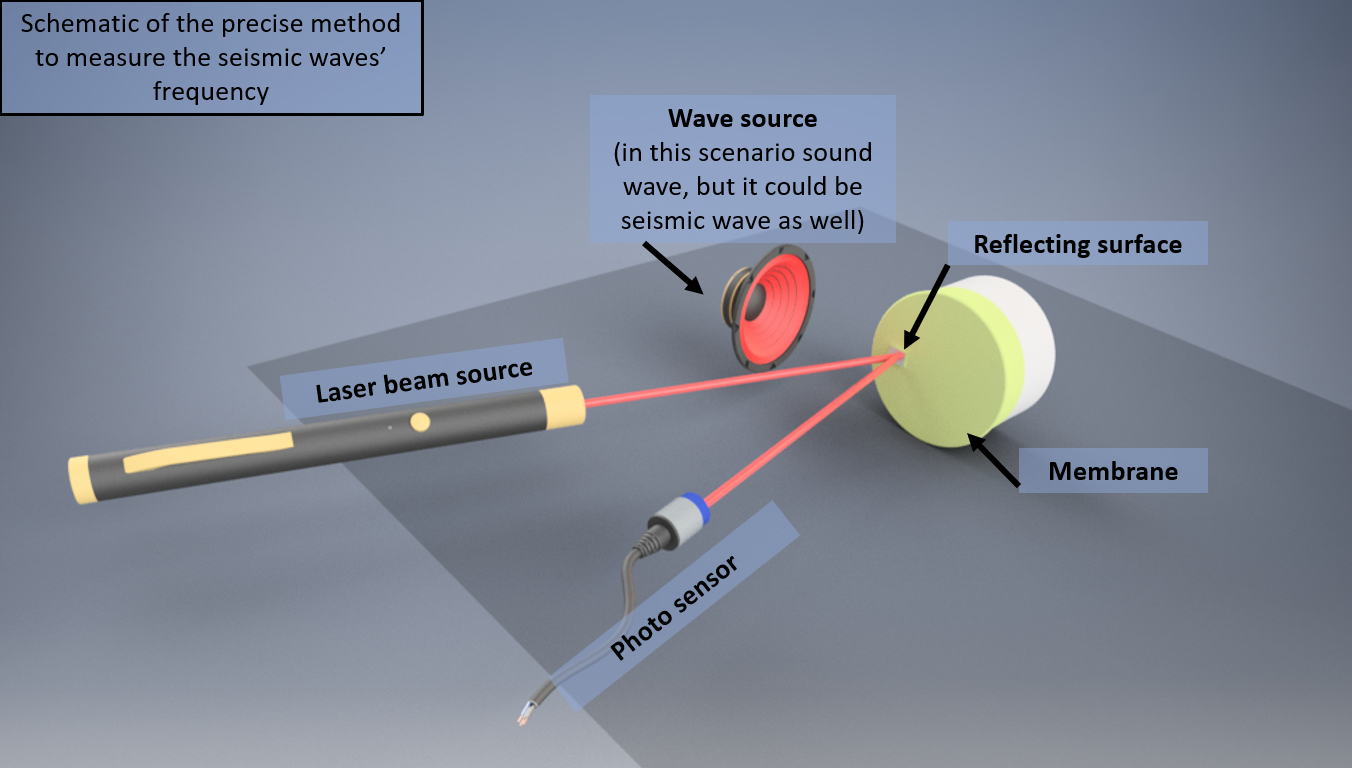
Figure 5: Arrangement of the system we are going to use to sense the frequency of earthquakes.
There are a lot of variables we should consider with this measuring apparatus, such as:
- the laser beams' input angle
- the laser sources' distance from the membrane
- the position of the reflecting surface on the membrane
- the elasticity properties of the membrane
Nevertheless, we performed an experiment to see if the apparatus could translate sound waves so that we can hear it. Here is a video about the results:
3. CONCLUSIONS
The OSCILLA system’s modular design can be readily implemented using conventional. OSCILLA is composed of steel-based cylindrical subunits that can be integrated into an underground structure; this unit can be placed around existing architecture and incorporated into new designs/construction in earthquake-prone areas. Unlike the costs of seismic retrofitting, the costs of implementing the OSCILLA would be substantially lower. According to recent estimates, the costs for retrofitting an average sized building could cost upwards of $100,000 USD. When extrapolated over an entire city, the costs of retrofitting are extremely prohibitive. In comparison, the cost of installing a OSCILLA system would be below an estimated $20,000 USD.

Figure 6: Cost of OSCILLA array compared with traditional Earthquake retrofitting costs
The advent of seismic metamaterials presents a novel method of mitigating earthquake destruction. The OSCILLA system, based on conventional materials such as rubber and steel, is a low-cost implementation of the seismic metamaterial framework and makes seismic metamaterials feasible in the near-term. The environmental durability of steel also allows OSCILLA to be deployed in nearly any climate, regardless of soil alkalinity or hygrometry.
In summary, OSCILLA presents an innovative way to reduce the economic and humanitarian harm of earthquakes.
WORK DONE
> Idea of the OSCILLA hardware, design, research and simulation: Jeremiah Pate
> Idea of the photo-microphone, research, design, experiments: Aron Molnar
 Aron Molnar
Aron Molnar